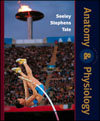 |  Houston CC: Anatomy & Physiology , 6/e Rod Seeley,
Idaho State University
Trent Stephens,
Idaho State University
Philip Tate,
Phoenix College
Preface| At the beginning of the twenty-first century, few things seem more inevitable than change. New knowledge continues to accumulate at a rapid pace. Changing technology has helped accelerate that process by dramatically improving the ability to uncover previously unknown facts that lead to amazing advancements. Molecular techniques have provided abundant new information about the structure and function of the body. New electronic instruments have improved the speed and precision of data collection and analysis. New imaging systems and analytical instruments that assess substance levels in blood and other body fluids have improved the ability to diagnose and treat ailments. Modern surgical instruments have led to the development of new procedures and have made old procedures much less invasive.
In spite of all of the changes, some things remain the same. Good science courses still help students learn basic information and instill the ability to carry out predictive and analytical thought processes. Excellent teachers who explain concepts and inspire students are essential. Good textbooks that provide clear explanations and include devices to cultivate the development of critical thinking are vital educational resources that assist students in achieving important educational goals.
Anatomy and Physiology is designed to help students develop a solid, basic understanding of anatomy and physiology without an encyclopedic presentation of detail. Great care has been taken to select important concepts and to carefully describe the anatomy of cells, organs, and organ systems. The basic recipe we have followed for six editions of this text is to combine clear and accurate descriptions of anatomy with precise explanations of how structures function and examples of how they work together to maintain life. To emphasize the basic concepts of anatomy and physiology, we have provided explanations of how the systems respond to aging, changes in physical activity, and disease, with a special focus on homeostasis and the regulatory mechanisms that maintain it. We have included timely and interesting examples to demonstrate the application of knowledge in a clinical context. For example, enough information is presented to allow students to understand the normal structure and function of the heart and how the heart responds to age-related changes. Enough information is presented to allow students to predict the consequences of blood loss and the effects of transfusions. This approach is both relevant and exciting. All content is presented within a framework of pedagogical tools that not only help students study and remember the material, but also challenge them to synthesize the information they gain from their reading and apply it to new and practical uses. Because they require a working knowledge of key concepts and stimulate the development of problem-solving skills, this text emphasizes critical thinking exercises as an important route to student success.
|
|



 2003 McGraw-Hill Higher Education
2003 McGraw-Hill Higher Education

 2003 McGraw-Hill Higher Education
2003 McGraw-Hill Higher Education